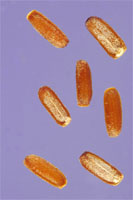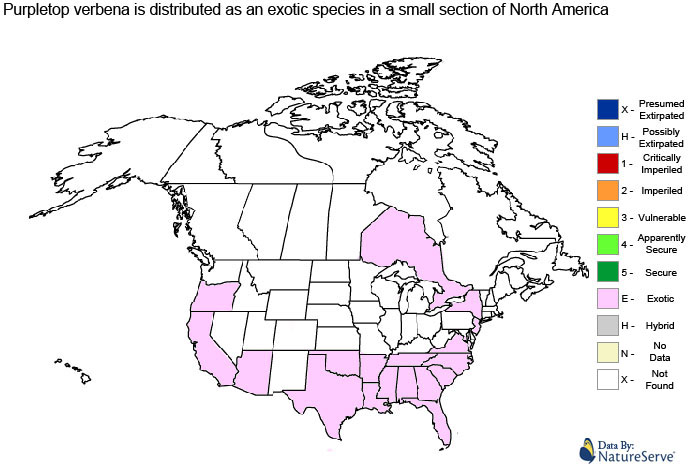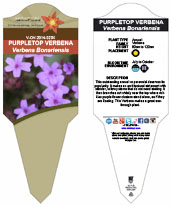

| Plant Name | Purpletop Vervain | |
| Scientific Name | Verbena Bonariensis | |
| Family | Verbena | |
| Plant Type | Perennial | |
| Start of Blooming Season | July | |
| End of Blooming Season | October |

| Soil Conditions | |
| Soil Moisture | |
| Sunlight | |
| Notes: |

Purpletop vervain is a tall and slender-stemmed perennial. It can grow to up to 120cm tall and can spread to 90 cm wide. At maturity, it will develop a woody base. Fragrant lavender to rose-purple flowers are in tight clusters located on terminal and axillary stems, blooming from mid-summer until fall frost. The stem is square with very long internodes. Leaves are ovate to ovate-lanceolate with a toothed margin and grow up to 10 cm long.


The following health hazards should be noted when handling or choosing a location to plant purpletop vervain:
 |
TOXIC Species in the verbena family contain glycoside verbenalin which can cause sickness or death. |
 |
ENVIRONMENTAL HAZARD Species in the verbena family can cause reproductive problems in cattle and photosensitization in other species |

 |
-Click here- or on the thumbnail image to see an artist rendering, from The United States Department of Agriculture, of purpletop vervain. (This image will open in a new browser tab) |

 |
-Click here- or on the thumbnail image to see a magnified view, from The United States Department of Agriculture, of the seeds created by purpletop vervain for propagation. (This image will open in a new browser tab) |

Purpletop vervain can be referenced in certain current and historical texts under the following four names:
Purpletop vervain can be translated into the following select languages:
| Arabic | الأرجواني الأعلى لويزة | Bulgarian | Chinese (Sim) | 紫金顶马鞭草 | |
| Croatian | Ljubičasta Vrh Verbena | Czech | Danish | ||
| Dutch | Esperanto | Purpura Top Kermeso | Estonian | ||
| Finnish | French | Violet Top Verveine | German | ||
| Greek | Hebrew | סגול למעלה ורבן | Hungarian | ||
| Italian | Japanese | パープルトップバーベナ | Korean | 보라색 탑 버베나 | |
| Low Saxon | Lithuanian | Violetinė viršų Verbenų | Norwegian | ||
| Persian | بنفش بالا گل شاه پسند | Polish | Portuguese | ||
| Romanian | Russian | Фиолетовый Топ Вербена | Slovak | ||
| Spanish | Swedish | Tagalog | |||
| Turkish | Ukrainian | Фіолетовий Топ Вербена | Vietnamese |

| The information provided in this conservation assessment has been provided by the Natureserve Database in conjuction with various federal, provincial, state, county, district, regional, and municipal governments as well as public and private conservation authorities. Information in this section is accurate from the last time this article was updated. | |
 |
Purpletop Vervain has no conservation status as it is considered an exotic and or invasive species in North America. |

 |

 |
The MIROFOSS database offers free printable garden tags for personal and non-profit use. These tags can be used to properly identify plant samples in a garden. Click on the tags shown on the the screen or -click here- to download a full size jpeg image for a purpletop vervain identification tag; which can be printed on paper or used with a plastic laser printer. |
 |
What's this? What can I do with it? |

| Folklore | D. S. Vohra (1 June 2004). Bach Flower Remedies: A Comprehensive Study. B. Jain Publishers.ISBN 978-81-7021-271-3. |
| Background | A-Z encyclopedia of garden plants. United Kingdom: Dorling Kindersley. 2008. p. 1136. ISBN 1405332964. |
| Background | Washington State Noxious Weed Control Board (WSNWCB) (2007): Tall Verbena, Purple Top, Cluster Flower Vervain |
| Biology | Yuan, Yao-Wu & Olmstead, Richard G. (2008): A species-level phylogenetic study of the Verbena complex (Verbenaceae) indicates two independent intergeneric chloroplast transfers. Molecular Phylogenetics and Evolution |
| Image Rendering | USDA-NRCS PLANTS Database / USDA NRCS. Wetland flora: Field office illustrated guide to plant species. USDA Natural Resources Conservation Service. |
| Environment | National Audubon Society. Field Guide To Wildflowers (Eastern Region): Alfred A. Knopf. pp 415-420 ISBN 0-375-40232-2 |
| Physical Identification | National Audubon Society. Field Guide To Wildflowers (Eastern Region): Alfred A. Knopf. pp 415-420 ISBN 0-375-40232-2 |
| May 01, 2015 | The last time this page was updated |
| ©2021 MIROFOSS™ Foundation | |
 |